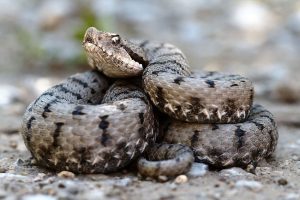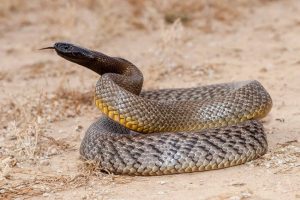Dubbed the most beautiful snake in the world, the Coral Snake is also considered one of the most dangerous, with a potent and highly toxic venom. To better understand this snake and learn about its characteristics, breeding season, and how to identify it, we invite you to read the following article from KnowAllAnimals. After reading, you’ll surely know more about this remarkable snake.
Scientific classification
- Kingdom: Animalia
- Phylum: Chordata
- Class: Reptilia
- Order: Squamata
- Suborder: Serpentes
- Superfamily: Elapoidea
- Family: Elapidae
1. Introduction to the Coral Snake
To help you better understand this unique snake, we’ll share all the relevant information, such as its origin, appearance, and breeding habits.
1.1. What Is a Coral Snake?
The Coral Snake belongs to the Elapidae family, which means it is closely related to other highly venomous and dangerous snakes like cobras, African vipers, terrestrial vipers, king cobras, kraits, and many others. Although it possesses an incredibly striking beauty, this snake is considered extremely dangerous due to the amount of venom it injects with each bite. For humans, the mortality rate is very high if bitten, as the snake’s venom enters the body quickly.
However, statistics show that the number of people attacked by this snake worldwide is very low. Its venom is typically used only for hunting prey. Once bitten, the prey is quickly incapacitated and has no chance of escaping.
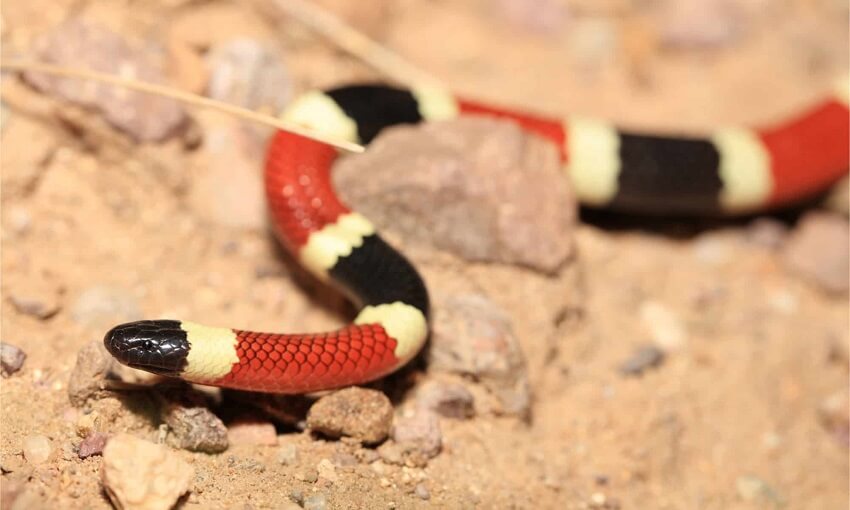
1.2. Origin of the Coral Snake
Currently, there are many species of coral snakes found worldwide, with up to 81 species having been discovered and widely publicized. However, the largest numbers of coral snakes are found in South America, North America, and coastal plains from North Carolina to Louisiana, as well as throughout the state of Florida.
In addition, some species are also found in many Southeast Asian countries like Indonesia, Brunei, Malaysia, Thailand, and Myanmar. They typically live at an altitude of 100–1,000 meters (330–3,300 feet) above sea level. Based on our research, this snake has not yet been discovered in Vietnam.
1.3. Physical Characteristics of the Coral Snake
There are many different species of coral snakes in the world today, so each has a different appearance and color. However, most have a slender body, a small head, and a plump, round torso. The head and body are distinctly separated by the neck. The snake’s scales are quite small, thick, and smooth, and they come in many different colors.
The most common coral snakes have distinct alternating bands of red, white, and black, which makes them stand out and look very colorful. However, some species have a bluish-green color, with a red head and tail. Others are mainly made up of alternating black and white bands, similar to the krait.
An adult coral snake can reach a length of 50–80 cm (20–31 inches), but there are some species that can grow to be almost 2 meters (6.5 feet) long, such as the blue coral snake. A special thing about this snake is its incredibly sharp and quick eyesight. It has the ability to see things from over 60 meters (200 feet) away, which makes hunting much easier.
1.4. Habits and Breeding Season of the Coral Snake
This snake species usually lives in areas with high humidity, a lot of moss, damp, soft soil, or under the fallen leaves of tropical forests. Typically, coral snakes only go out to hunt during the rainy season or the breeding season. They go out to hunt to get enough energy for mating and laying eggs.
Additionally, despite being a highly venomous snake, they love to live and swim in the water, and they spend a large portion of their time submerged. They will usually go out to hunt at night when the rainy or breeding season arrives. Their diet consists mainly of small animals like frogs, toads, fish, shrimp, birds, mice, and eggs. They use their venom to kill their prey, then slowly swallow and digest it.
The breeding season for this snake usually starts at the beginning of the rainy season. This is the time when the food supply is plentiful and the living environment is very suitable for this snake, which helps their eggs hatch faster. When the breeding season arrives, the male will seek out a female. Once the female accepts, they will mate. The male will then leave, and the female will find a spot and lay her eggs. In each breeding season, a female will lay 3–5 eggs. The female will protect the eggs, and the young will hatch after about 2–3 months. After hatching, the young snakes will separate and live independently.
1.5. Lifespan of the Coral Snake
Typically, snakes have a long lifespan, and if the living environment is favorable with plenty of food, this snake can live for an average of 7–8 years, with many individuals living up to 10–12 years. However, the habitat of snakes and other wild animals is shrinking due to human encroachment, which makes it more difficult for them to survive and thrive.
2. Is the Coral Snake Venomous? Is It Dangerous?
The coral snake is known to be an EXTREMELY VENOMOUS snake, related to other venomous snakes like cobras, king cobras, kraits, and many others. This snake is especially dangerous because its venom glands run along its entire body. However, like many other venomous snakes, they usually don’t have the intention of actively attacking humans; they only defend themselves and attack when they feel threatened. Cases of being bitten are often due to people accidentally stepping on them or touching them.
According to biologists, the venom of this snake is neurotoxic and cytotoxic, inhibiting the nervous system, affecting cells, and preventing blood clotting. This causes the victim to experience local paralysis, followed by localized pain, dizziness, disorientation, blurred vision, rashes, shortness of breath, respiratory and heart failure, and eventually death if not treated promptly.
A unique thing about this snake is that, unlike many other venomous snakes that try to inject as much venom as possible with a bite, the coral snake has the ability to control the amount of venom it injects. The amount of venom they release with each bite can range from 2–12 mg. This results in victims having different symptoms and degrees of danger depending on the amount of venom injected. The window of danger can be anywhere from 2–26 hours if a victim does not receive first aid and treatment.
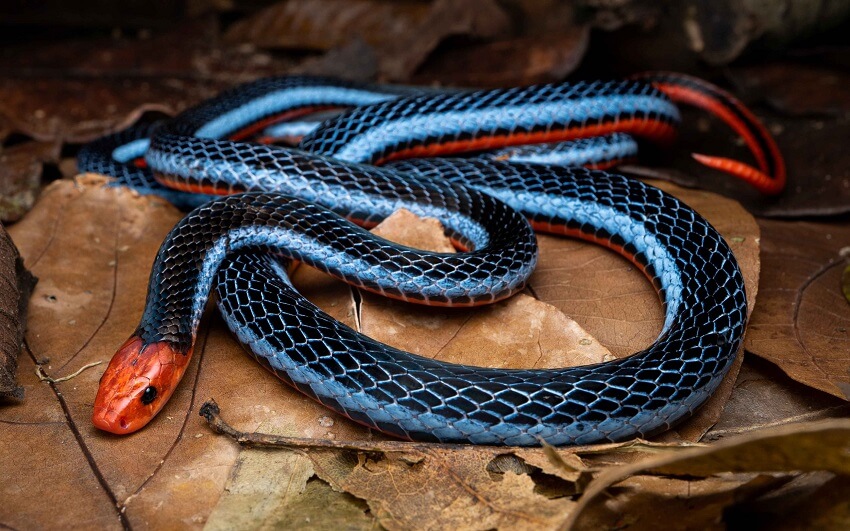
3. How to Identify a Coral Snake Bite and Treat It Effectively
Identifying a coral snake bite versus a bite from another snake will make the first aid and treatment process more effective, especially if the victim is unconscious or unable to identify the attacker.
3.1. How to Identify a Coral Snake Bite
Here are some key characteristics to help you determine if a bite was from a coral snake or another species:
Coral snakes are typically very gentle and not aggressive. Most cases of bites are from accidentally touching them while gardening, clearing brush, or stepping on them while walking in the forest. In many cases, this snake will burrow underground, leaving only its tail exposed.
The fangs of this venomous snake are very small, so the bite usually leaves only two small puncture marks on the skin and does not cause a large wound.
The degree of danger depends on the amount of venom injected. If not treated in time, the victim can experience a range of symptoms and varying levels of risk.
Characteristic symptoms of a bite from this snake are: The bite marks will often fade, then reappear later. There is little swelling, but it can cause symptoms such as respiratory and heart failure, vomiting, disorientation, fainting, rashes, difficulty breathing, and death if not treated promptly.
3.2. First Aid for a Coral Snake Bite
When you or someone else is bitten by this snake or any other venomous snake, first aid is extremely important. It can effectively prevent the venom from spreading deeper into the body, which makes the treatment process more effective. Here is how to treat a venomous snake bite:
First, you need to stay calm if you are the one bitten. If it is someone else, you need to reassure them to help them stay calm. This will keep their heart from beating fast and prevent the venom from spreading deeper into the heart and blood vessels.
Do not let the victim move or walk. Immobilize the limb or the area of the bite with a splint or tourniquet placed above the wound.
If the bite is on an arm or leg, you should remove any sleeves, pants, or jewelry, as this can cause the wound to swell.
Apply a pressure immobilization bandage for snakes like kraits, vipers, and cobras. This helps to slow the onset of paralysis.
You can use a rubber band, cloth, or bandage to tie the wound, but it should only be moderately tight.
You should not cut, squeeze, or suck the venom from the wound.
If the victim has difficulty breathing, perform artificial respiration. If there are signs of cardiac arrest, perform CPR and wait for medical personnel to arrive.
Transport the victim to the hospital, and continue to apply the pressure bandage and keep the bite area lower than the heart. If the bite is on an arm or leg, let the limb hang down.
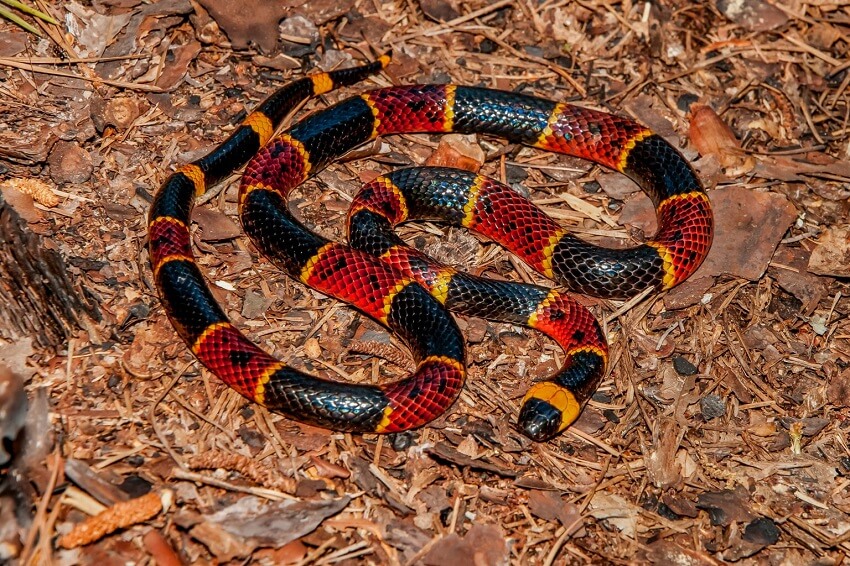
4. Popular Coral Snake Species Today
Experts have discovered approximately 81 different species of coral snakes living and thriving worldwide. However, they have identified three species as the most common and numerous: the blue, red, and white-headed coral snakes. Specifically:
4.1. Red Coral Snake
This is an extremely venomous snake that has a particularly striking and attractive appearance. The red coral snake is found in large numbers in the tropical forests of Florida, Alabama, Mississippi, and southeastern Carolina. They have also been found in small numbers in southern Georgia. They are named for the distinctive red color on their bodies, which is highlighted by alternating black and white bands. Typically, these unique snakes have two or three main colors.
This snake is classified as one of the most dangerous and venomous snakes in the world today. However, they have a rather shy nature and often hide from predators. They only truly attack when hunting or to defend themselves when humans accidentally touch them.
4.2. Blue Coral Snake
This snake has a very attractive appearance, with skin covered in a vibrant turquoise color, along with some distinctive orange on its tail and head. In addition to the signature blue color, they also have a few white and red spots that make them stand out. However, this is an extremely venomous snake. They are identified as the culprit in approximately 2.8% of the 4,200 snake attack incidents in Colombia.
This snake is found in large numbers in South America, and in Asia, they are also found in Thailand and Malaysia. They have a nocturnal hunting habit and are especially dangerous to humans.
4.3. White-Headed Coral Snake
This snake is not as common or numerous as the red and blue species we mentioned. However, they are also one of the most dangerous venomous snakes today. This snake is mainly found in South America, central Brazil, Paraguay, Argentina, and Bolivia.
This snake’s appearance and colors are not as striking as other species of coral snakes. Its main colors are white and red, making it look similar to a krait. The tip of its head is white, which is why it is called the white-headed coral snake.

5. FAQs
1. Are coral snakes dangerous to humans?
Yes, coral snakes have potent neurotoxic venom, but they are generally shy and rarely bite unless provoked.
2. How can you tell a coral snake from its non-venomous lookalikes?
The common rhyme is “Red touch yellow, kill a fellow; red touch black, friend of Jack.” This helps distinguish venomous coral snakes from harmless mimics like the milk snake.
3. Where are coral snakes commonly found?
They are typically found in the southeastern United States, Central America, and parts of South America, often in wooded or sandy areas.
Know All Animals has shared useful information about this extremely venomous snake with you. We are confident that this article has helped you answer your questions about what a Coral Snake is, if it’s venomous, and how dangerous it is in a detailed and accurate way. Thank you for reading our article.
References: https://en.wikipedia.org/wiki/Coral_snake

